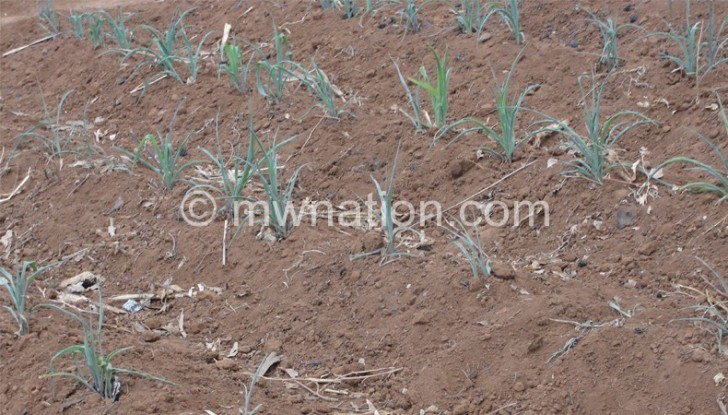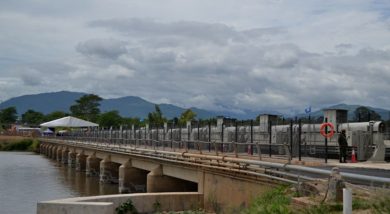Crop disaster
A bleak outlook for this year’s crop output is emerging as dry spells scorch crops nationwide, subsidised fertiliser delays to reach the right people at the right time and, even where the cheaper input is available, some subsistent farmers do not have the cash to buy it, The Nation has established.

Some agriculture development divisions (ADDs) The Nation talked to over the past week and our own observations in some districts such as Chikwawa and Chiradzulu show that the country should brace for another sharp agriculture output drop in 2016 after the 30 percent slump in the 2015 season largely due to floods and drought.
That crop underperformance has left more than 2.8 million people starving and a K23 billion (about $ 34.4million) bill to feed them for three to six months beginning October even as the food crisis further destabilises an already troubled macroeconomic environment characterised by high inflation and interest rates; a depreciating kwacha and a widening —budget gap.
Our random checks indicate that most farmers in rain-fed farming have started panicking because of the situation and are just waiting, with bated breath, that the situation improves.
Some parts of the country The Nation visited, particularly the Southern Region, have not received rains for weeks and the crops, currently at variant stages of development, have now started wilting.
The most vulnerable are farmers who had already applied fertiliser to their maize, the staple grain, and have described the unfolding situation as threatening their livelihoods.
The Department of Climate Change and Meteorological Services said some three weeks ago that the country, particularly the Southern Region, would experience a reduction in rainfall.
In Chikwawa, besides the dry spell, there is an outbreak of army worms that are also striking the already drying crops in the fields.
Programme manager for Shire Valley Agricultural Development Division (ADD), Jerome Nkhoma, confirmed in an interview that some parts of his zone have been attacked by army worms.
He also said for about two weeks now, most areas have not been receiving rains and the crops have started weakening.
Said Nkhoma: “People are already worried and complaining about the condition and if rains do not come anytime soon there are fears that the army worms outbreak may spread further as they do well in this type of condition.”
The weak crop scenario is also unfolding in most parts of the country such as Machinga, Blantyre, Phalombe, Kasungu and Mzimba where panic-stricken farmers and agriculture officials are painting a gloomy harvest picture.
Blantyre ADD deputy programme manager Aggrey Kamanga and Palichi Munyenyembe, district agricultural development officer (Dado) for Machinga also confirmed that the situation was dire.
“For the past week we have experienced dry spells in some parts of the ADD such as Phalombe, Chiradzulu, Blantyre and Mulanje and we just hope that the situation will improve very soon,” explained Kamanga.
Most areas have also been affected with the delays in the distribution of inputs under the Farm Input Subsidy Programme (Fisp) which made farmers procure the inputs late, according to ADD officials we talked to.
While some already applied fertiliser, thousands others who delayed to acquire the input are just keeping them in their houses awaiting the rains to start falling in earnest.
Amina Fanuel, from Traditional Authority (T/A) Tengani in Nsanje, told The Nation last week that after coming out empty-handed during the previous farming season she sees no hope of harvesting anything this year too.
She said despite her family receiving the Fisp coupons she could not afford to raise the cash to buy the inputs.
“There is nothing to expect. I could not raise the amount to buy the inputs because my family is already depleted, struggling and food insecure so the little we get goes directly to purchasing food and other basic necessities.
“We are faced with a terrible situation, the maize fields wilt away in front of our eyes. It is hard to cultivate under the circumstances we are in,” she complained.
As part of reforming Fisp, starting this farming season, government adjusted upwards farmers’ contribution to the farm inputs from K500 (about $ 0.7) to K8 500 (about $12); representing a K1500 (about $2) contribution towards a three kilogramme (kg) bag of maize seed and K3 500 each for a bag of NPK and Urea fertiliser .
Malawi is already experiencing one of the worst hunger situations in recent years following the drop in maize production due to combined effects of floods and drought earlier last year.
In September last year, President Peter Mutharika appealed to development partners both local and international to help government in mobilising resources to feed the 2.8 million Malawians—roughly 20 percent of the 16 million strong population—who do not have food in 25 of the country’s 28 districts.
Immediately, the World Food Programme (WFP) pledged to provide food aid to 2.4 million people nationwide, representing around 85 percent of the starving population.
This season’s number of hungry people—three times more than the food-deficit people recorded last year—is also the highest in 10 years and poses both fiscal and monetary policy challenges given the strategic nature of food to the country’s economy, especially on headline inflation; and on budgetary operations.
The last time the country registered another serious food crisis was during the 2012/13 farming season when 1.63 million people were food insecure. n






Despite a poor start to Malawi’s rainy season, many people are finding natural and sustainable solutions to the problems of climate change. These pictures were all taken on the same day (Jan. 4, 2016) at Never Ending Food near Chitedze. The healthy crops on the right are all organic, non-GMO, and diversified using local seeds that have been saved for free. Solutions exist, but we need to begin to move away from the expensive, chemically-dependent, monocropping of a maize-only agriculture.
True ‘climate-smart’ agriculture is that which is regenerative, healing, and works in accordance with natural systems. These two pictures were both taken on the same day (Jan. 4, 2016) and in the same area (Chitedze). The healthy picture on the right shows the amazing resilience that can be achieved with just a bit of attention to soil and plant health. The picture on the right is planted in healthy soil which is rich in organic matter, allowing to absorb and store moisture for longer periods of time. It is also planted with local seeds that have been saved for free. Solutions exist!